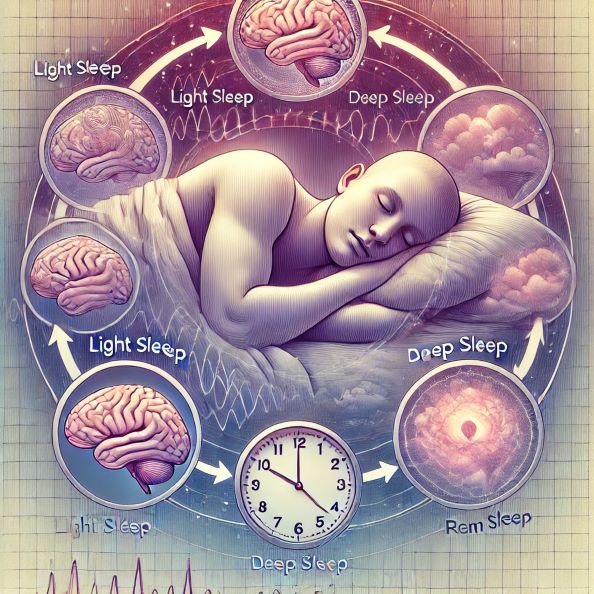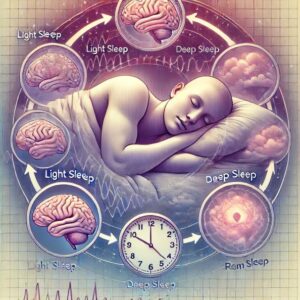Stages of sleep – durations of approximately 1.5 hours. Each sleep phase differs in brain activity, as scientifically proven by studies where sleeping subjects were connected to an EEG machine for observing brain activity.
Additionally, the sleep cycle phases change throughout the entire night of rest. Initially, the REM phase lasts longer, and the person is less responsive to external stimuli. However, after a couple of cycles, the situation shifts. Sleep becomes more sensitive, and the REM phase increases.
Stages of sleep
The duration of rapid and slow sleep phases varies throughout the night. Each of these stages has its own characteristics and effects, significantly influencing a person’s rest.
Initial sleep stage
The first sleep phase in adults – the process of falling asleep or dozing – lasts for 5-10 minutes. In foreign literature, it is referred to as the SREM phase (from the English “slow rolling eye movements”).
Key features of this stage include:
- Decreased motor activity
- Muscle relaxation
- Transition from alpha rhythm to theta waves reflects the brain’s shift from wakefulness to sleep
- Possible visions and absurd thoughts, which are normal.
This stage is considered light as the person responds quickly to stimuli and can wake up easily.
Light sleep
The second stage occupies about 50% of all sleep. The body continues to relax, and the eyes are nearly motionless except for slow movements. Additionally, the perception threshold gradually decreases (except for hearing, which remains sensitive).
In this stage, brain activity is characterized by:
- Dominance of theta waves on the EEG
- High-amplitude waves (sleep spindles) that gradually increase and then fade
- Appearance of K-complexes.
Sleep spindles and K-complexes are the primary characteristics that contribute to the gradual disconnection of consciousness. At this moment, sleep becomes the most stable, but in between sleep spindles, the person can wake up easily.
Slow sleep phase
There are not only phases of deep and rapid sleep. For instance, slow sleep is further divided into two subcategories (moderately deep sleep and deep sleep). The 3rd and 4th phases combine into slow-wave sleep (SWS), also known as delta sleep. In this case, delta waves occupy slightly less than 50% of the time in the third stage and slightly more in the fourth. During this period, a person falls deeply asleep, nearly unresponsive to external stimuli. The eyes do not move, and brain activity reaches a minimum. In the first half of the night, the duration of this sleep can last up to 40 minutes.
Key characteristics of this phase include:
- The person is in deep sleep and cannot wake up easily.
- Dominance of delta waves
- Body temperature reaches its lowest point during the night; the same applies to brain activity
- A sense of time distortion, where one may sleep for several hours yet feel as if they just laid down a minute ago.
The 3rd and 4th stages account for about 20-23% of total sleep time. During this phase, sleep spindles and sharp spikes appear in the cerebral cortex, directly connected to memory processes as well as the gathering and analysis of information. These stages contribute importantly to understanding what are the phases of sleep.
Rapid sleep phase
REM sleep or the fifth stage is characterized by vivid dreams and intense brain activity. What phase of sleep do you dream? Dreams can occur in other phases, but they are most distinct and “alive” during REM sleep. The main indication of this phase is the rapid eye movements (REM), temperature fluctuations, and irregular breathing.
Several features can be highlighted:
- Complete muscle relaxation, except for facial muscles and limbs, which may twitch or move.
- Body temperature fluctuations attributed to redirected blood flow to the brain and increased metabolism.
- EEG activity displays dominantly alpha and beta rhythms, as well as sawtooth waves. The former emerges during wakefulness, indicating a clear perception of the surroundings, while the latter are specific and characteristically present only during the REM phase.
- Theta waves in the hippocampus, associated with memory processes.
- PGO waves arise from bursts of activity in the brainstem affecting the visual cortex.
Thanks to the unique blend of complete muscular relaxation and heightened brain activity, the REM phase opens up vast possibilities for lucid dreaming.
Duration of sleep
The time spent in fast and slow sleep phases fluctuates during the night of rest. All phases within the cycle change; initially, deep sleep predominates, but as morning approaches, it shortens. Conversely, the rapid phase lengthens, potentially reaching 30-40 minutes in the final cycle.
The duration of sleep for an adult ranges from 6 to 8 hours per day, but deviations can occur from 4 to 10 hours. However, if systematic disturbances are present, the balance of NREM and REM phases can change, leading to serious negative changes in the body, including chronic insomnia and the development of psychological conditions.
Considering a stable 8-hour sleep, the durations of the phases would be as follows:
- Drowsiness – up to 10 minutes at the start of each cycle;
- Light sleep – 3-4 hours;
- Moderately deep sleep – around 40 minutes;
- Deep sleep – 0.5-1 hour;
- Rapid sleep – 1.5-2 hours.
Cycles repeat approximately every 90 minutes, with each new cycle lengthening the rapid sleep duration while shortening deep sleep.
According to recent studies, REM sleep first manifests in the fetus during the 3rd trimester. This indicates that this phase of sleep plays a crucial role in the internal stimulation of brain activity, especially important under limited external stimuli. The REM phase is vital for the development and maintenance of the stability of the central nervous system.
Regarding what are the two sleep phases called, they are generally referred to as NREM (non-rapid eye movement) and REM (rapid eye movement) sleep, with NREM further divided into light and deep sleep stages which create the entire cycle.
Book by Mikhail Raduga – Phase
FAQ
We recommend reading
Human sleep phases – How they work
REM phase – What is it and what is it characterized by?
How long does the REM phase last
Rapid eye movement sleep (REM phase) – what is it and what is it characterized by









